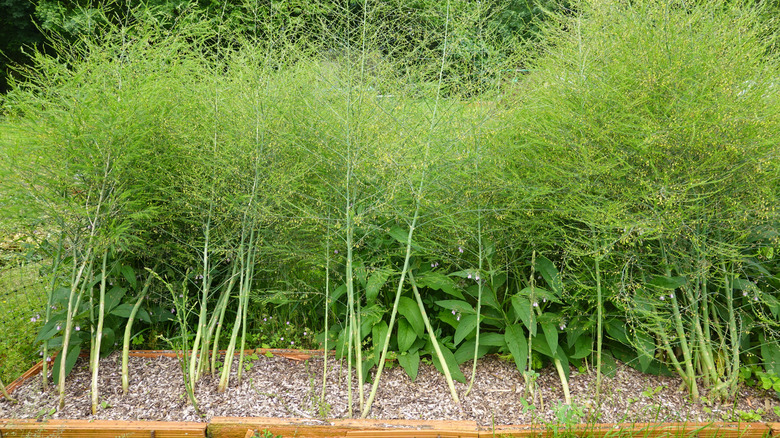How To Successfully Grow Asparagus In Your Container Garden
Asparagus (Asparagus officinalis) is a popular vegetable to add to your garden, favored for its flavorful spears and multiple harvests. Unlike many vegetables that are annuals, asparagus is a perennial that can produce harvests for more than 15 years when they are taken care of properly. While there are some common issues you should know about before growing asparagus, overall, it is a low-maintenance plant to care for and is a great candidate for container gardening. Container gardening offers a practical solution for gardeners limited on space, allowing even those with just patios, balconies, or small yards to grow this perennial vegetable successfully. Growing asparagus in a container successfully starts with choosing the right container size. Providing plenty of sunshine, using fertile, well-draining soil, and watering properly are all factors that contribute to successful growth of your potted asparagus.
As long as you are not making the crucial mistakes many make when growing asparagus such as using the wrong soil or not watering properly, you can grow healthy asparagus plants that produce strong, flavorful spears. Patience is the key with asparagus due to the fact that it will take two or three growing seasons before you should harvest. For the pot, you'll need one that is at least 18 inches deep and 12 inches wide with plenty of drainage holes on the bottom. Once you have chosen the right container, find a location for the asparagus that provides at least eight hours of sunlight daily, and make sure there are no trees or bushes that will shade the asparagus.
How to grow asparagus in containers so they thrive
If you think you will need to move the asparagus container around, put rollers on it before filling it with soil. A container with rollers will also allow you to move it around to ensure your asparagus gets the full eight hours of light each day. Choose well-draining soil that has compost or manure added to it to create a nice fertile soil bed. Aim for a pH of 6.5 to 7.5 as asparagus prefers higher pH soils. Dig a hole at least 6 to 12 inches in loose soil or 4 to 6 inches in heavier soil and add the crowns. Then cover with a 1-inch layer of compost and 2 to 3 inches of soil before watering.
Keep the soil moist, especially during the hot summer months. Since the asparagus is in containers, the soil will dry out faster, increasing the amount of water the vegetable needs. During the first year, water on a regular basis. An inch of water per week is a good rule of thumb. Overwatering is a common occurrence, especially among beginners, but you can apply these ideas to make sure you never overwater your plants again. A good crop of ferns is necessary for a good harvest the following spring. At the end of the season, don't cut back your ferns unless they are completely dead, as the crowns get nutrients from the ferns as they are dying. At the third year, harvest for two to three weeks and then six to eight weeks per harvest in subsequent seasons to allow the ferns to grow sufficiently between harvest times.

